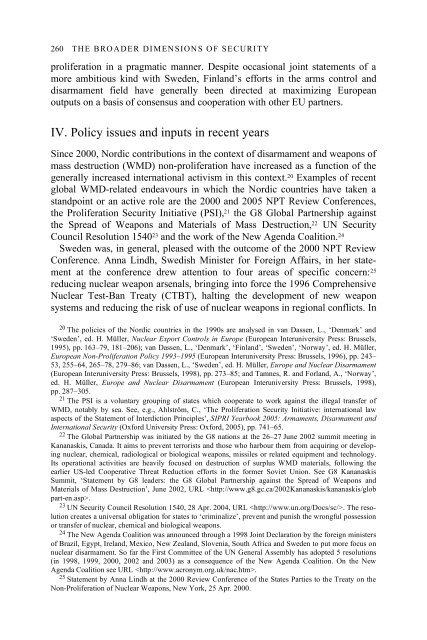The Nordic Countries and the European Security and Defence Policy
The Nordic Countries and the European Security and Defence Policy
The Nordic Countries and the European Security and Defence Policy
- No tags were found...
You also want an ePaper? Increase the reach of your titles
YUMPU automatically turns print PDFs into web optimized ePapers that Google loves.
260 THE BROADER DIMENSIONS OF SECURITYproliferation in a pragmatic manner. Despite occasional joint statements of amore ambitious kind with Sweden, Finl<strong>and</strong>’s efforts in <strong>the</strong> arms control <strong>and</strong>disarmament field have generally been directed at maximizing <strong>European</strong>outputs on a basis of consensus <strong>and</strong> cooperation with o<strong>the</strong>r EU partners.IV. <strong>Policy</strong> issues <strong>and</strong> inputs in recent yearsSince 2000, <strong>Nordic</strong> contributions in <strong>the</strong> context of disarmament <strong>and</strong> weapons ofmass destruction (WMD) non-proliferation have increased as a function of <strong>the</strong>generally increased international activism in this context. 20 Examples of recentglobal WMD-related endeavours in which <strong>the</strong> <strong>Nordic</strong> countries have taken ast<strong>and</strong>point or an active role are <strong>the</strong> 2000 <strong>and</strong> 2005 NPT Review Conferences,<strong>the</strong> Proliferation <strong>Security</strong> Initiative (PSI), 21 <strong>the</strong> G8 Global Partnership against<strong>the</strong> Spread of Weapons <strong>and</strong> Materials of Mass Destruction, 22 UN <strong>Security</strong>Council Resolution 1540 23 <strong>and</strong> <strong>the</strong> work of <strong>the</strong> New Agenda Coalition. 24Sweden was, in general, pleased with <strong>the</strong> outcome of <strong>the</strong> 2000 NPT ReviewConference. Anna Lindh, Swedish Minister for Foreign Affairs, in her statementat <strong>the</strong> conference drew attention to four areas of specific concern: 25reducing nuclear weapon arsenals, bringing into force <strong>the</strong> 1996 ComprehensiveNuclear Test-Ban Treaty (CTBT), halting <strong>the</strong> development of new weaponsystems <strong>and</strong> reducing <strong>the</strong> risk of use of nuclear weapons in regional conflicts. In20 <strong>The</strong> policies of <strong>the</strong> <strong>Nordic</strong> countries in <strong>the</strong> 1990s are analysed in van Dassen, L., ‘Denmark’ <strong>and</strong>‘Sweden’, ed. H. Müller, Nuclear Export Controls in Europe (<strong>European</strong> Interuniversity Press: Brussels,1995), pp. 163–79, 181–206); van Dassen, L., ‘Denmark’, ‘Finl<strong>and</strong>’, ‘Sweden’, ‘Norway’, ed. H. Müller,<strong>European</strong> Non-Proliferation <strong>Policy</strong> 1993–1995 (<strong>European</strong> Interuniversity Press: Brussels, 1996), pp. 243–53, 255–64, 265–78, 279–86; van Dassen, L., ‘Sweden’, ed. H. Müller, Europe <strong>and</strong> Nuclear Disarmament(<strong>European</strong> Interuniversity Press: Brussels, 1998), pp. 273–85; <strong>and</strong> Tamnes, R. <strong>and</strong> Forl<strong>and</strong>, A., ‘Norway’,ed. H. Müller, Europe <strong>and</strong> Nuclear Disarmament (<strong>European</strong> Interuniversity Press: Brussels, 1998),pp. 287–305.21 <strong>The</strong> PSI is a voluntary grouping of states which cooperate to work against <strong>the</strong> illegal transfer ofWMD, notably by sea. See, e.g., Ahlström, C., ‘<strong>The</strong> Proliferation <strong>Security</strong> Initiative: international lawaspects of <strong>the</strong> Statement of Interdiction Principles’, SIPRI Yearbook 2005: Armaments, Disarmament <strong>and</strong>International <strong>Security</strong> (Oxford University Press: Oxford, 2005), pp. 741–65.22 <strong>The</strong> Global Partnership was initiated by <strong>the</strong> G8 nations at <strong>the</strong> 26–27 June 2002 summit meeting inKananaskis, Canada. It aims to prevent terrorists <strong>and</strong> those who harbour <strong>the</strong>m from acquiring or developingnuclear, chemical, radiological or biological weapons, missiles or related equipment <strong>and</strong> technology.Its operational activities are heavily focused on destruction of surplus WMD materials, following <strong>the</strong>earlier US-led Cooperative Threat Reduction efforts in <strong>the</strong> former Soviet Union. See G8 KananaskisSummit, ‘Statement by G8 leaders: <strong>the</strong> G8 Global Partnership against <strong>the</strong> Spread of Weapons <strong>and</strong>Materials of Mass Destruction’, June 2002, URL .23 UN <strong>Security</strong> Council Resolution 1540, 28 Apr. 2004, URL . <strong>The</strong> resolutioncreates a universal obligation for states to ‘criminalize’, prevent <strong>and</strong> punish <strong>the</strong> wrongful possessionor transfer of nuclear, chemical <strong>and</strong> biological weapons.24 <strong>The</strong> New Agenda Coalition was announced through a 1998 Joint Declaration by <strong>the</strong> foreign ministersof Brazil, Egypt, Irel<strong>and</strong>, Mexico, New Zeal<strong>and</strong>, Slovenia, South Africa <strong>and</strong> Sweden to put more focus onnuclear disarmament. So far <strong>the</strong> First Committee of <strong>the</strong> UN General Assembly has adopted 5 resolutions(in 1998, 1999, 2000, 2002 <strong>and</strong> 2003) as a consequence of <strong>the</strong> New Agenda Coalition. On <strong>the</strong> NewAgenda Coalition see URL .25 Statement by Anna Lindh at <strong>the</strong> 2000 Review Conference of <strong>the</strong> States Parties to <strong>the</strong> Treaty on <strong>the</strong>Non-Proliferation of Nuclear Weapons, New York, 25 Apr. 2000.
















